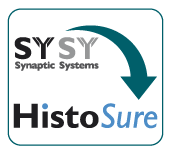|
|
|
|
| Cat. No. HS-442 008 |
50 µg purified recombinant IgG, lyophilized. Albumin and azide were added for stabilization. For reconstitution add 50 µl H2O to get a 1mg/ml solution in PBS. Then aliquot and store at -20°C to -80°C until use. Antibodies should be stored at +4°C when still lyophilized. Do not freeze! |
| Applications | |
| Clone | Rb301F10 |
| Subtype | IgG1 (κ light chain) |
| Immunogen | Synthetic peptide corresponding to residues surrounding AA 280 of mouse Chil3 (UniProt Id: O35744) |
| Reactivity |
Reacts with: mouse (O35744). No signal: human. Other species not tested yet. |
| Specificity | Specific for mouse Chil3/YM1; no cross-reactivity with Chil4/YM2 |
| Remarks |
This antibody is a chimeric antibody based on the monoclonal rat antibody SY-301F10. The constant regions of the heavy and light chains have been replaced by rabbit specific sequences. The antibody can therefore be used with standard anti-rabbit secondary reagents. The antibody has been expressed in mammalian cells. |
| Data sheet | hs-442_008.pdf |
 Important information
Important information|
|
Chitinase-like protein 3 (Chil3), commonly referred to as YM1, is a rodent-specific secreted glycoprotein that belongs to the chitinase-like protein (CLP) family, sharing structural similarity with true chitinases but lacking enzymatic activity. It is predominantly expressed by alternatively activated (M2) macrophages, eosinophils, and neutrophils in mice, particularly under type 2 immune conditions such as allergic inflammation, parasitic infection, and tissue repair (1). Chil3 / YM1 expression is strongly induced by IL-4 and IL-13, hallmark cytokines of Th2-driven responses. Alongside Arginase-1 (Arg1) and Fizz1 (Retnla), Chil3 / YM1 is commonly used as a biomarker of M2 macrophage polarization in murine models (2). In healthy adult mice, Chil3 / YM1 is constitutively expressed in alveolar macrophages and neutrophils in the lung and in immature neutrophils in the spleen and bone marrow (1). Its isotype Chil4 / YM2 shows a different expression pattern and is mainly expressed in the stomach (3). In the central nervous system microglia can also induce Chil3 / YM1 expression under specific inflammatory conditions, e.g. after stroke (4).